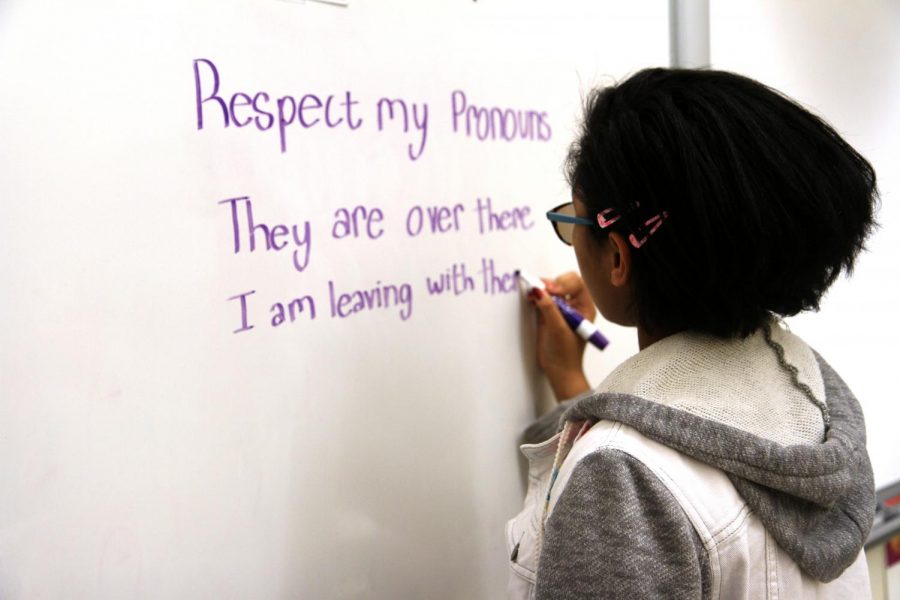Students shed light on what it means to be non-binary
Non-binary facts and falsehoods explained
Non-binary sophomore Lia Lynn writes their pronouns on the board, demonstrating sentences in which their pronouns can be used. Oftentimes, students are told their pronouns are not grammatically correct. this, however, is a fallacy.
April 26, 2019
The non-binary gender identity is not common knowledge, but more and more people are identifying with it, and as of 2016, those who identify as non-binary make up about 25-35% of the transgender population. Studies show that about 700,000 to 1,000,000 people make up the transgender community, leaving us with somewhere between 245,000 to 350,000 people that may identify as non-binary.
“Non-binary is a category for gender identities that are not exclusively masculine or feminine, [including] identities which are outside the gender binary and cisnormativity [meaning male and female-identifying people who identify with the gender they are assigned at birth],” Ocean Howard, a sophomore explains.
Non-binary people usually express a combination of masculinity and femininity, or neither, in their gender expression, meaning the way they dress or otherwise present themselves to the world. As such, the term non-binary is typically used as an umbrella term to encompass various gender expressions. This includes other identities such as genderfluid, agender, genderqueer, and terms that are also used within the transgender community. Agender is defined as a genderless identity, carrying neither elements of masculinity or femininity. This particular identity is not as common, but a more specific label for those who wish to use it. Genderqueer is another term used and those who identify as such don’t quite adhere to conventional gender distinctions, but may identify as both, neither, or a combination of both male and female.
Under the non-binary umbrella there is genderfluid, which is someone who fluctuates between the gender binary that we have set. Joey Jensen, sophomore, explained, “Someone who is genderfluid, can switch on how they identify. Some days, they might feel more comfortable looking and acting more to the masculine side of the spectrum, because gender is a spectrum. Or the next day they might feel more feminine, or one day they could feel neither or both.” Each experience is unique to those who identify as genderfluid.
Gender is a spectrum and one can express their gender in any way they want. Non-binary people may present more masculine, more feminine, and others may just be completely androgynous. This may be through how they dress and act, and the way that many may present themselves and their identity will vary from individual to individual. However, the science behind gender and sex is much more complicated. On the subject of gender and biological sex, Harvard University researcher Katherine J. Wu states that , “Sex determination – the way we are ‘coded’ into a biological sex – is complicated in and of itself. There are far more options than just ‘male’ or ‘female,’ and countless instances of species that can actually transition from one sex to another within a single lifetime.”
A common misconception about non-binary people is that they are not considered transgender, or a part of the trans community. “By dictionary definition, transgender means one who doesn’t identify with their sex given at birth and non-binary people don’t [identify with their sex given at birth] so why wouldn’t they be transgender or belong in that community?” Said Joey Jensen. Those who identify as non-binary aren’t typically associated with the transgender label because many non-binary people don’t undergo sex transformation surgery. Nonetheless, non-binary does fall within the category of transgender. In fact, the white stripe in the transgender flag is representative of those who are questioning, non-binary, or identify with a term underneath that umbrella.
Both identities may suffer from gender dysphoria, and is actually quite common, but not universal. Gender dysphoria is by dictionary definition, “the condition of feeling one’s emotional and psychological identity to male or female to be opposite of one’s biological sex.” Many non-binary and transgender people experience all kinds of gender dysphoria, There are many subcategories to gender dysphoria, localized to different aspects of the body, like one’s voice, height, or reproductive organs (commonly referred to as top or bottom dysphoria). Both top and bottom dysphoria are the most common within the trans/non-binary communities. 0.
There are people in the non binary spectrum who have a little bit of the binary genders within them so they may switch from She/Her to He/Him or They/Them. But They/ Them aren’t the only pronouns for non-binary people.There are pronouns called Neopronouns also known as new pronouns. For example some non binary people may use ze/zir/zirs [zee/zeer/zeers].
The pronouns They/Them/Their have historically been used to denote individuals of indiscernible sex, and continues to be used today by the LGBTQ+ community because the pronouns are genderless. In recent years, however, ut Neopronouns or New pronouns have been used in place of “She”, “He”, and “Them”. An example of neopronouns would be Ze/hir/hirs, and those who may not be comfortable with any of the listed neo/pronouns above make their own. Many non-binary people may choose to change their name to something less gender-nonconforming (GNC), or more androgynous.
Names can shape who someone is as a person, and how people view you, and can be an essential part to expressing how one presents themselves and their gender identity. It’s something that someone will spend an incredible amount of time thinking about so they choose the name that feels best for them. However, some may change their name a few times just to find the right one. Deadnaming is a term used within the LGBTQ+ community to refer to someone by their previous name rather than their chosen name.
For students out there who may not understand, Ocean Howard had this to say, “We’re real people who just want our identities respected. We don’t like being referred to as our sex given at birth or our deadname. We like to be referred to as the identity we are and the name we have chosen.” Whether a non-binary person wants to present themselves as androgynous, or masculine, or even feminine they are a valid non binary person.





